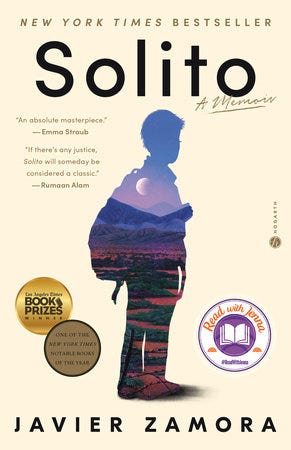Bookworm: March 2025
'Solito,' 'State of Wonder,' 'The Wife Upstairs,' 'The Fox Wife,' 'The Optimist's Daughter'
This post contains an affiliate link or links. If you use a link to buy a book, I may earn a small commission. You can find all the books that have been featured in this newsletter in my Bookshop store.
Guff
Table of contents
‘Solito’: Memoir, by Javier Zamora
‘State of Wonder’: Fiction, by Ann Patchett
‘The Wife Upstairs’: Fiction, by Rachel Hawkins
‘The Fox Wife’: Historical fiction, by Yangsze Choo
‘The Optimist’s Daughter’: Fiction, by Eudora Welty
“Solito”
What if everyone in a community read the same book? That’s the fun premise behind my local library’s annual Everybody Reads program. Every year I look forward to the chosen title and the accompanying author event.
This year, my library chose “Solito,” a memoir by the poet Javier Zamora. The title means “Alone,” but I like to think of it as “Little One Alone” — “solo” meaning “alone,” and the suffix “-ito” meaning a diminutive, often an affectionate one.
Zamora was indeed little, just 9 years old, when his parents hired a man known as a “coyote” to take him from their hometown in El Salvador to the town where they were living and working in California. The concept of going to America was familiar to the boy. He’d seen many classmates vanish abruptly to go to “La USA.” He knew the coyote his parents were negotiating with — the same man had taken his mother north. And his family members took it for granted that he would eventually reunite with his parents.
Written in a blend of English and untranslated Spanish, “Solito” took me on a moving, thought-providing journey of anticipation, anxiety, anguish and a dozen other emotions. While young Javier’s grandfather accompanied him on the first stage of the trip, a bus ride to Guatemala, after that he was essentially on his own. He was fortunate in being placed in a group that included a woman traveling with her slightly older daughter; the mother took him under her wing and presented him as her son in public. In general, his age offered little protection; to the white Americans he encountered, he was just a smaller migrant.
Zamora doesn’t get into policy or politics, legality or criminality, or fairness or unfairness in “Solito.” He writes about the journey wholly from his 9-year-old perspective: what happened, what he saw and heard and tasted and smelled and touched, and how he felt. During his author event, he talked about being put in art therapy soon after his arrival in the U.S. The therapist encouraged him to draw his feelings. He ended up producing a book of drawings that he couldn’t bear to look at for two decades. When he finally did, it became the basis for “Solito.” I am glad he was able to reopen that book and provide us with this richly detailed memoir.
Today, Zamora lives in the house in Tucson, Arizona, that provided the first roof over his head in America.
“State of Wonder”
I’ve been slowly but steadily making my way through Ann Patchett’s literary oeuvre. I admire her powerfully lyrical prose, her characters who are wholly realized people, and her versatile pivoting from topic to topic. (It doesn’t hurt that she owns an independent bookstore, Parnassus Books, my favorite kind of retailer. Definitely on my list if I ever visit Nashville again.)
“State of Wonder” is the seventh Patchett book I’ve read, and I enjoyed it as much as the previous six. It opens with a death and more or less works its way backward from there as its characters try to resolve the mystery surrounding said death and the mission the man was on.
Marina Singh, an obstetrician-turned-pharmacologist at a pharmaceutical company called Vogel, is working in her Minnesota lab one evening when Vogel’s CEO shows up with a letter. It says that her lab partner of seven years, Anders Eckman, has died deep in the Amazon jungle. The letter is from Annick Swenson, who’s been working in the jungle for years on a drug development project for Vogel that she’s kept shrouded in secrecy. Eckman was sent south to get a progress report, found Swenson and then caught a fatal fever.
Between Eckman’s grieving widow and Vogel’s continuing need to understand exactly what Swenson is doing on the company dime, Marina finds herself on a plane to Brazil. It’s the complete ecological opposite of Minnesota — her arrival there is not unlike the moment in “The Wizard of Oz” when the film changes from black and white to color. As it happens, Marina loves Minnesota’s climate. If growth requires discomfort, she’s about to embark on a boatload of growth.
Patchett adds another twist: Decades ago, Marina was Swenson’s student, but fled medicine in guilt and shame after making a mistake in the delivery room.
“State of Wonder” is a thriller on multiple levels: personal, ecological, scientific. What a thrill it was to read.
“The Wife Upstairs”
I’m a sucker for a good retelling of a classic novel I love, and this is a wonderful one. Rachel Hawkins’ “The Wife Upstairs” takes a lifelong favorite, Charlotte Bronte’s “Jane Eyre,” and turns it inside out and upside down with riveting results.
What if Jane was a modern-day social climber who became a dog walker so she could insinuate herself into the local social elite? What if Edward Rochester was Eddie, the handsome wealthy widower of a millionaire CEO? And what if each of them, not just him, had a really big secret they didn’t want anyone else to know?
Add a big helping of Southern Gothic, and you’ve got yourself a page-turning romantic thriller. Hawkins clearly knows her Eyre inside and out. She plays adeptly with Bronte’s original plot and characters; I particularly enjoyed her take on St. John Rivers, the original Jane’s cousin-turned-suitor. Hawkins has created a novel that can stand sturdily on its own but that’s also much more entertaining if you can spot and gather all the Easter eggs.
I’d love to say more, but I don’t want to spoil the fun. Many thanks to the friend who passed this book along.
“The Fox Wife”
Yangsze Choo’s “The Fox Wife” came to my attention courtesy of a conversation about another novel I recently read, Amanda Lee Koe’s “Sister Snake.” When I described “Sister Snake” as a reworking of a famous Chinese folk tale, someone else commented that it sounded similar to the book she was reading. A couple weeks later, I spotted “The Fox Wife” on a library shelf.
Choo writes in an afterword:
I’ve always been fascinated by old Chinese tales of fox women (and men) who tempt and beguile humans. Traditionally, women labeled vixens were accused of willfulness, strong emotions, and licentious living. The stories told about these shape-shifting foxes are brief and elliptical; as a child I always wondered where they came from and what they were up to in between these episodes, written down in Chinese literature as “histories.”
How wonderful for us that Choo decided to turn her imagination loose amid these fox tales. “The Fox Wife,” set in China in 1908, is told from two perspectives: that of a centuries-old fox woman who’s on a personal mission of vengeance, and that of an aging human detective whose success hinges on his secret and mysteriously acquired ability to detect lies. We follow as their paths gradually converge. Along the way, we get a tale of magic, families, first loves and second chances. There’s even a happy ending.
“The Optimist’s Daughter”
Eudora Welty is one of those authors I’ve long heard about but never actually read. When I recently came across a reference to her Pulitzer Prize-winning novel, “The Optimist’s Daughter,” I decided to change that.
Welty’s first published works were newspaper columns and short stories, both of which require an economical approach to prose that is evident in “The Optimist’s Daughter.” It’s written in four taut sections set shortly after World War II in Louisiana and Welty’s home state of Mississippi. The action is launched by a pivotal doctor’s appointment for the title optimist, a Mississippi judge. After Judge McKelva has eye surgery that leaves him immobile in a hospital bed, his adult daughter, Laurel, and her not-much-older stepmother, Fay, find themselves forced together like magnets facing north pole to north pole. Acrimony and revelations ensue.
Welty wrote of “The Optimist’s Daughter” that she wanted to focus on what she called the progression of human relationships.
Their tensions act as the directing force; and the plot of the novel tests the movement and pull, with and against, the power and strength of kinship.
In less than 200 pages, Welty explores relationships of multiple kinds — familial, marital and communal — through the lenses of loss and grief. The tensions will be familiar to anyone who’s tested the pull of kinship.
Happy reading!







I read Solito last year and found it to be a good read. I wish my library had chosen it for its community read this year.
thanks for this, I agree re State of Wonder.